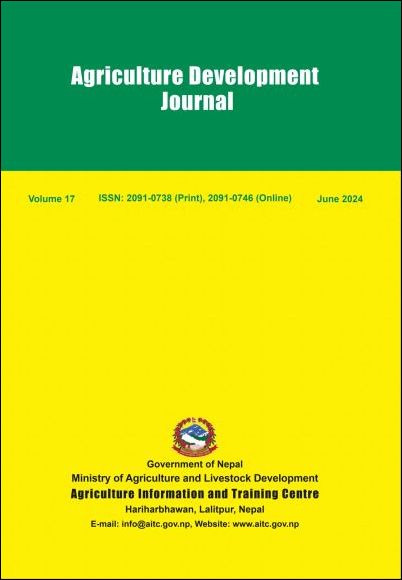Prevalence of Snails and Farmers' Practice Towards the Management of Giant African Snail, Achatina fulica Bowdich, 1822 in Kapilvastu, Nepal
DOI:
https://doi.org/10.3126/adj.v17i1.67872Keywords:
Ghonghi, Hand-picking, Invasive-pest, Kitchen-garden, ManagementAbstract
The Giant African Snail (GAS), Achatina fulica Bowdich, 1822, is the world's largest, most damaging, and highly invasive land snail, capable of consuming about 10% of its body weight daily and affecting at least 500 types of plants. Despite the high incidence of this pest, management options are limited and ineffective. In this context, this study was carried out to assess overall snail distribution, damage and management practices adopted by farmers against GAS. A household survey of randomly selected 60 households was carried out using semi-structured questionnaires at Banganga Municipality-01, Kapilvastu, Nepal. The results revealed the prevalence of three different snails: the GAS, Achatina fulica Bowdich, 1822, the Common snail, Indoplanorbis exustus (Deshayes, 1834), and the Paddy Snail or Ghonghi or Ghongi, Pila globose (Swainson, 1822) in moist areas, drains, and grassy lands, among them, GAS causing the most significant damage during the rainy season. The most vulnerable stage of crops to GAS was the vegetative stage of development (53.3%) in vegetables and fruits, with the most preferred crop family being the Cucurbitaceae (45%). The majority of respondents (48%) believed that the lack of effective control measures was the main reason for the growing infestation and extent of damage. The 'Hand-picking and killing' method was considered the most effective and suitable method in the farming community over other control measures. It has been reported that the snail problem has increased over the years, and very little effort has been made by the concerned authorities to manage this pest. In conclusion, snails, especially GAS, pose major challenges to agricultural production in Nepal. Therefore, appropriate and cost-effective management strategies are required for their sustainable management.




